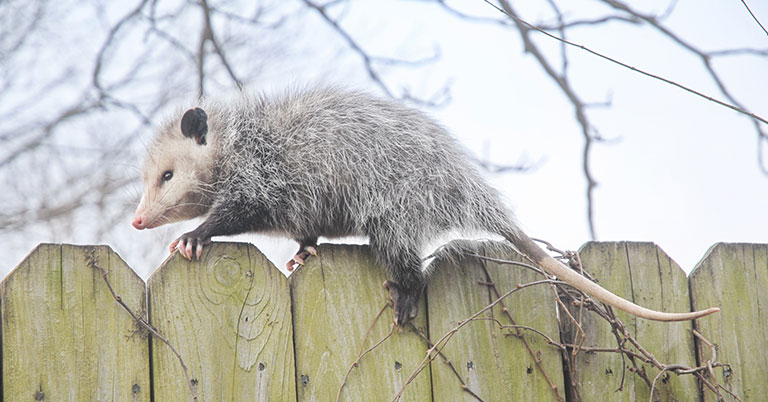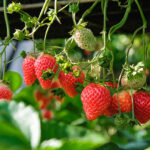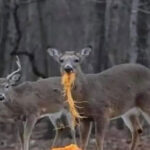
What To Do If You See An Opossum (And Why You Should Support Them)
- Thomas Nelson
- September 22, 2023
- Animals
- 0 Comments
Whether you’ve glimpsed them scampering through your backyard or discovered them in the shadows of the urban landscape, these opossums have a way of sparking curiosity and often a mix of emotions.
In this article, we embark on a journey to better understand opossums, those remarkable creatures with distinctive looks and fascinating behaviors. We’ll explore the graceful art of coexisting with them, unraveling the dos and don’ts when you cross paths with these shy, nocturnal wanderers.
From encounters in your own backyard to road encounters and beyond, we’ll provide insights into how to respond when you see an opossum and how to support these valuable members of the wild world around us. By the end of this guide, you’ll not only be prepared to greet opossums with a compassionate heart but also equipped to contribute to their well-being in ways you might not have imagined. So, let’s venture into the realm of opossum encounters, where respect and appreciation await.
What are opossums?
Opossums, commonly known as “possums” in North America, are a group of marsupial mammals belonging to the family Didelphidae. They are predominantly found in the Americas, with the Virginia opossum (Didelphis virginiana) being the most recognizable and widely distributed species. These creatures possess several distinctive characteristics that set them apart from other mammals.
Opossums, like kangaroos and koalas, are marsupials, a group of mammals known for giving birth to relatively undeveloped live young, called joeys. What makes marsupials unique is the presence of a pouch on the mother’s belly, where these young ones continue to develop after birth. It’s this pouch that distinguishes marsupials from other mammals.
In terms of physical appearance, opossums have a distinct and somewhat unusual look. They sport a pointed snout, naked ears, and a prehensile tail that sets them apart. This tail is not only used for balance but can also grasp objects, making it a versatile tool for climbing and holding onto things. The fur of opossums can vary in color, ranging from gray to black or brown, often with a lighter face and a pinkish nose.
Opossums are primarily nocturnal creatures, meaning they are most active during the night. Their excellent night vision and keen sense of smell help them navigate the darkness and locate food sources. Their diet is highly opportunistic, encompassing a wide range of foods, including insects, small rodents, fruits, vegetables, carrion, and even scavenged items from human garbage when it’s available.
Opossums have some unique defense mechanisms. When they feel threatened, they may hiss, growl, or display their teeth. One of their most famous behaviors is “playing possum.” When confronted by a predator, opossums may fall limp, lie on their side, and even excrete a foul-smelling fluid. This behavior often deters predators that are not interested in eating carrion.
Despite their adaptability, opossums have relatively short lifespans in the wild, typically living only 1-2 years. This shorter lifespan is due to various factors, including predation, disease, and accidents.
Why are opossums good?
Opossums, often underappreciated and misunderstood, actually offer several valuable benefits in various ecosystems. Here are some reasons why opossums can be considered beneficial:
- Natural Pest Control: Opossums are voracious eaters of insects and other small pests. They help control populations of garden pests, such as beetles, grubs, ticks, and even cockroaches. Their diet includes many creatures that gardeners and homeowners consider nuisances.
- Carrion Cleanup Crew: Opossums are scavengers and play a vital role in cleaning up carrion, which includes dead animals on roadsides or in the wild. By consuming carrion, they help prevent the spread of diseases and reduce unpleasant sights and smells associated with decaying animals.
- Tick Reduction: Opossums are particularly effective at reducing the population of ticks, which can transmit diseases like Lyme disease and Rocky Mountain spotted fever. Research has shown that opossums can kill thousands of ticks in a single week by grooming themselves.
- Seed Dispersal: Opossums unintentionally aid in seed dispersal. As they move through various habitats and feed on fruits, some seeds stick to their fur and are transported to new locations, helping with the spread of plant species.
- Low Risk of Rabies: Opossums have a lower body temperature than many other mammals, which makes them less susceptible to rabies. Their body temperature creates an environment that is less conducive to the survival and replication of the rabies virus.
- Natural Balance: Opossums occupy a niche in the ecosystem as both predator and scavenger. Their presence helps maintain a balance in the food web, preventing overpopulation of certain prey species and ensuring that no resources go to waste.
- Disease Control: While opossums can carry diseases like any wild animal, they can help control the spread of some diseases by consuming infected insects and small mammals, reducing the risk of disease transmission to humans.
- Indicators of Environmental Health: Opossum populations can serve as indicators of environmental health. Their presence in an area may suggest a stable and relatively healthy ecosystem.
It’s important to note that while opossums offer these ecological benefits, they are also part of natural food chains and are preyed upon by various predators. Additionally, they have adapted to live in urban and suburban environments, where they often encounter human-related challenges and dangers. For these reasons, it’s essential to coexist with opossums peacefully, rather than considering them nuisances or pests.
Overall, opossums contribute to the health and balance of ecosystems in numerous ways, making them valuable members of the natural world.
How to support your local opossums
Supporting your local opossums is not only a way to appreciate these unique creatures but also a means to promote biodiversity and ecological balance. Here are some ways to support and help your local opossums thrive:
- Provide Food and Water: Opossums are omnivores, so you can offer them a variety of foods. Leave out pet food, fruits, vegetables, and small amounts of meat (cooked or raw). Make sure to provide a shallow dish of fresh water, especially during dry spells.
- Create Shelter: Opossums need safe places to rest and hide during the day. Brush piles, woodpiles, and dense vegetation can provide shelter. If you have a yard, consider leaving a corner in a natural state to offer cover.
- Avoid Harmful Chemicals: Refrain from using pesticides and herbicides in your garden or yard. These chemicals can harm opossums directly or indirectly by killing the insects they feed on.
- Secure Trash: Opossums are scavengers, and they may be attracted to garbage. Use secure, wildlife-resistant trash cans to prevent them from accessing your waste.
- Minimize Road Hazards: Many opossums are killed by cars while crossing roads. Drive carefully, especially at night, in areas where opossums are known to live. If you find an injured opossum on the road, safely move it to the side if possible or contact local wildlife rehabilitation experts for assistance.
- Pet Awareness: If you have pets, be mindful of them when opossums are around. Opossums are generally not aggressive and will likely try to escape, but it’s essential to avoid unnecessary confrontations.
- Avoid Relocation: If you discover an opossum in your yard, don’t attempt to relocate it. Opossums are territorial and may have a nest nearby. Simply leave them alone, and they will likely move on when they feel safe.
- Educate Others: Share your knowledge about opossums with friends and neighbors. Dispelling common myths and misconceptions about these animals can foster a more positive attitude toward them.
- Support Local Wildlife Rehabilitation Centers: If you come across an injured or orphaned opossum, contact a local wildlife rehabilitation center for assistance. These organizations have the expertise to care for injured wildlife and prepare them for release back into the wild.
- Promote Habitat Conservation: Support local conservation efforts and initiatives that protect natural habitats, which are essential for opossums and other wildlife. Get involved in local conservation organizations and participate in habitat restoration projects.
By taking these steps, you can create a more opossum-friendly environment in your community and contribute to the well-being of these valuable, albeit often misunderstood, members of your local ecosystem.
What should you do if you see an opossum?
If you happen to come across an opossum in your vicinity or on your property, it’s essential to approach the situation with care and consideration. These creatures are generally not aggressive and are more likely to respond to encounters with fear or avoidance. To begin, maintain a safe distance and allow the opossum to go about its business at its own pace.
Avoid cornering or threatening it, as this can lead to defensive behaviors like hissing or growling. Keep your pets, especially dogs, away to prevent stress for both animals. It’s important not to attempt to handle the opossum, as they are wild animals and may bite if they feel threatened.
In cases where the opossum finds itself in an enclosed area, such as a garage or shed, provide an open exit route to allow it to leave on its own. For injured or orphaned opossums, it’s best to contact a local wildlife rehabilitation center or wildlife rescue organization. They possess the expertise to provide appropriate care and rehabilitation.
When encountering an opossum on the road, practice road safety by slowing down and allowing the animal to cross safely, as opossums are often victims of car accidents. In essence, the key approach is to respect and peacefully coexist with these valuable members of the ecosystem, recognizing their role in pest control and maintaining ecological balance.

